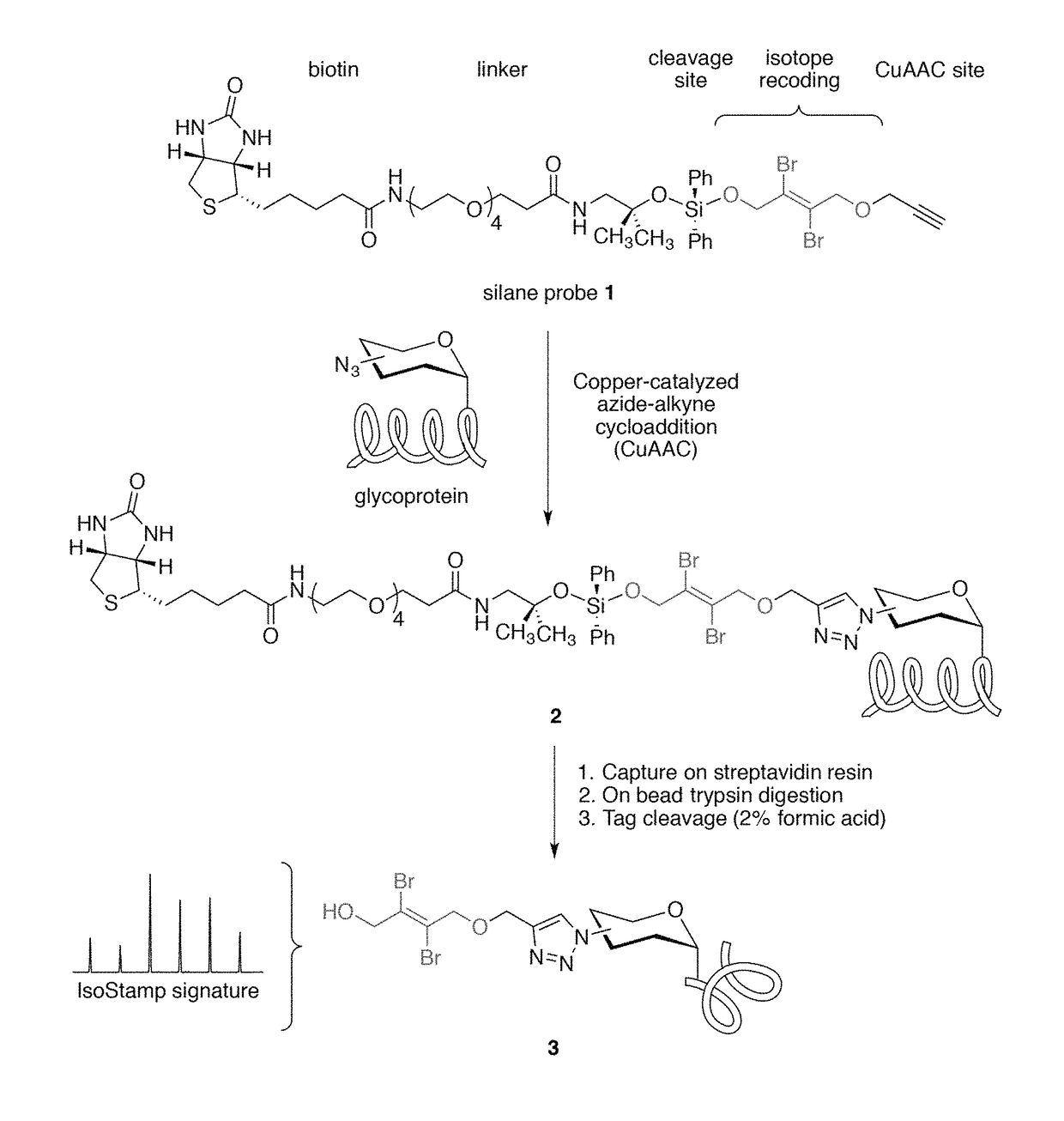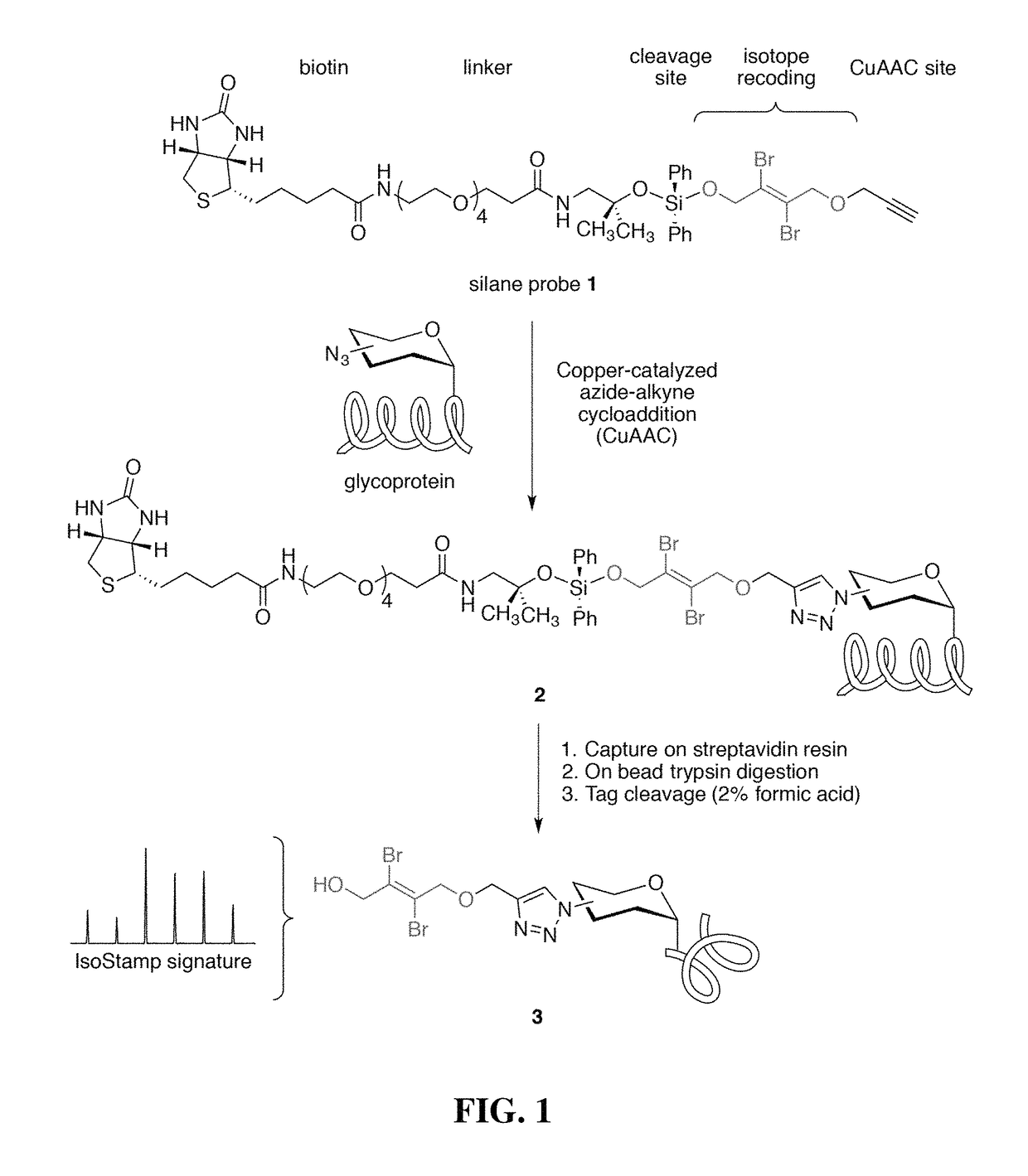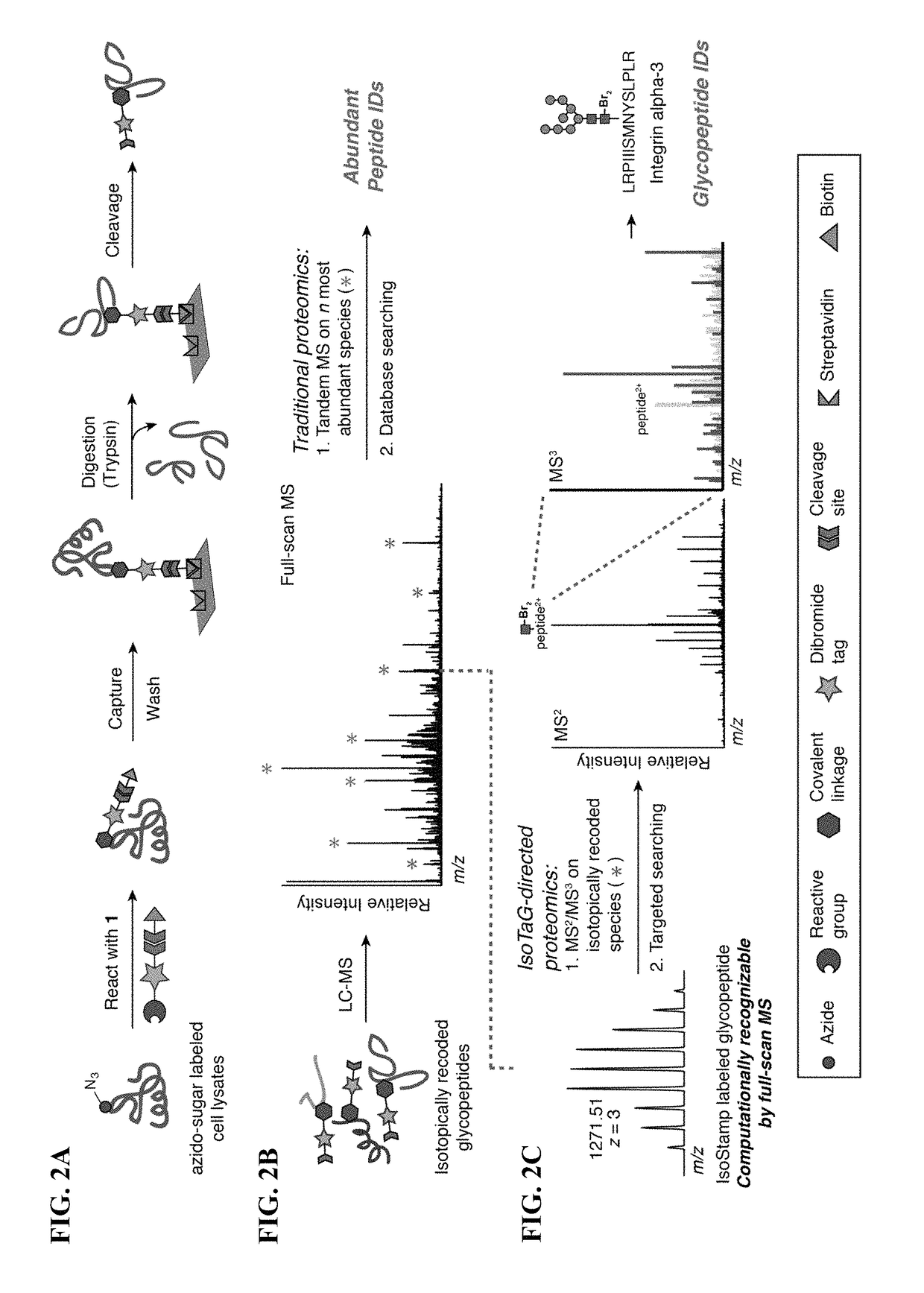Cleavable probes for isotope targeted glycoproteomics and methods of using the same
a technology of isotope targeted glycoproteomics and probes, which is applied in the field of probes for isotope targeted glycoproteomics and methods of using the same, can solve the problems of reducing detection by mass spectrometry, stymie detection and computational analysis, and psps that are not characterized, and present significant computational challenges on the proteome level
- Summary
- Abstract
- Description
- Claims
- Application Information
AI Technical Summary
Benefits of technology
Problems solved by technology
Method used
Image
Examples
example 1
General Experimental Procedures
[0119]All reactions were performed in single-neck, flame-dried, round-bottomed flasks fitted with rubber septa under a positive pressure of nitrogen, unless otherwise noted. Air- and moisture-sensitive liquids were transferred via syringe or stainless steel cannula. Organic solutions were concentrated by rotary evaporation at 30-33° C. Normal and reverse phase flash-column chromatography was performed as described by Still and co-workers.1 Normal phase purifications employ silica gel (60 Å, 40-63 μm particle size) purchased from Silicycle (Quebec, Canada). Analytical thin-layered chromatography (TLC) was performed using glass plates pre-coated with silica gel (0.25 mm, 60 Å pore size) impregnated with a fluorescent indicator (254 nm). TLC plates were visualized by exposure to ultraviolet light (UV) and / or submersion in aqueous ceric ammonium molybdate solution (CAM) followed by brief heating on a hot plate (120° C., 10-15 s).
[0120]Chemical Materials. C...
example 2
Synthetic Procedures
[0123]
Synthesis of (E)-2,3-Dibromo-4-(prop-2-yn-1-yloxy)but-2-en-1-ol (S2)
[0124]
[0125]Propargyl bromide (80% solution in toluene, 1.25 mL, 11.6 mmol, 1 equiv) was added to a stirred solution of (E)-2,3-dibromobut-2-ene-1,4-diol (S1, 8.56 g, 34.8 mmol, 3.00 equiv) and potassium hydroxide (1.30 g, 23.2 mmol, 2.00 equiv) in 50% N,N-dimethylformamide-water (30 mL) at 24° C. The resulting mixture was stirred for 12 h at 24° C. The product mixture was purified by flash-column chromatography (eluting with 25% ethyl acetate-hexanes, grading to 100% ethyl acetate, one step) to afford (E)-2,3-dibromo-4-(prop-2-yn-1-yloxy)but-2-en-1-ol (S2) as a white solid (2.69 g, 82%). Rf=0.26 (20% ethyl acetate-hexanes; CAM). 1H NMR (400 MHz, CDCl3): δ 4.49 (s, 4H, H1 / H2), 4.14 (d, 2H, J=2.4 Hz, H3), 3.28 (t, 1H, J=6.8 Hz, OH), 2.49 (t, 1H, J=2.4 Hz, H4). 13C NMR (600 MHz, CDCl3): δ 125.3 (C), 118.6 (C), 78.8 (C), 75.5 (CH), 72.8 (CH2), 66.8 (CH2), 57.2 (CH2). IR (NaCl), cm−1: 3295 (br)...
example 3
Cell Culture and Enrichment Procedures
[0128]All cell lines were obtained from the American Type Culture Collection (ATCC) and maintained at 37° C. and 5% CO2 in a water-saturated incubator. Cell lines were metabolically labeled between passages 4-7 (MCF-7), 6-10 (Jurkat), or 17-22 (PC-3). Cell densities were counted using a hemacytometer and seeded at 1×105 cells / mL at the start of metabolic labeling experiments. Jurkat and PC-3 cells were maintained in RPMI-1640 supplemented with 10% FBS and 1% penicillin / streptomycin. MCF-7 cells were maintained in DMEM supplemented with 10% FBS and 1% penicillin / streptomycin.
Metabolic Labeling of Adherent Cell Lines (PC-3, MCF-7):
[0129]Tetraacetylated N-azidoacetylgalactosamine (Ac4GalNAz) and tetraacetylated N-azidoacetylmannosamine (Ac4ManNAz) were prepared as 500 mM stock solutions in dimethylsulfoxide (DMSO). Tissue culture dishes (150 mm) were seeded with 100 μM of Ac4GalNAz, Ac4ManNAz, or vehicle control containing DMSO (3.0 μL). Six dishes...
PUM
| Property | Measurement | Unit |
|---|---|---|
| dissociation constant | aaaaa | aaaaa |
| dissociation constant | aaaaa | aaaaa |
| dissociation constant | aaaaa | aaaaa |
Abstract
Description
Claims
Application Information
 Login to View More
Login to View More - R&D
- Intellectual Property
- Life Sciences
- Materials
- Tech Scout
- Unparalleled Data Quality
- Higher Quality Content
- 60% Fewer Hallucinations
Browse by: Latest US Patents, China's latest patents, Technical Efficacy Thesaurus, Application Domain, Technology Topic, Popular Technical Reports.
© 2025 PatSnap. All rights reserved.Legal|Privacy policy|Modern Slavery Act Transparency Statement|Sitemap|About US| Contact US: help@patsnap.com



